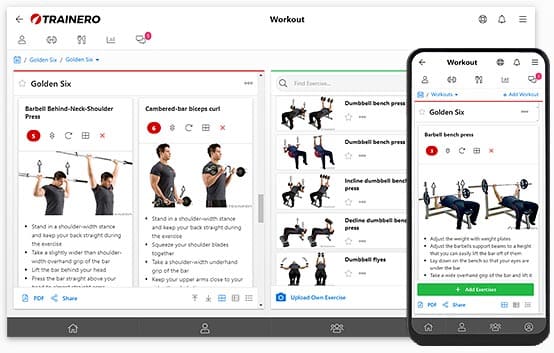RIR (Reps in Reserve): The Strength Training Technique You Need to Know
Strength training and resistance training, techniques are constantly evolving to optimize performance and results. One such technique that has gained significant attention is Reps in Reserve or Repetitions in Reserve (RIR). Understanding and implementing RIR in your training can be a game-changer, especially for those aiming to enhance their strength and muscle hypertrophy. Let’s delve into what RIR is and why it is essential for your workout regimen.

Unlock your fitness potential with Trainero! Get a 14-day free trial and access personalized workout plans, expert coaching, and progress tracking—all in one app. No commitments, just results. Start your free trial today and take your fitness journey to the next level!

Understanding RIR and Its Importance
What is Reps in Reserve?
Reps in Reserve (RIR) is a subjective measure used to determine how many repetitions you can perform before reaching muscle failure. Essentially, it is the number of reps left in a set before you can no longer maintain proper form or complete another rep with good technique. RIR allows you to gauge the intensity of your workout and adjust your effort accordingly, ensuring you are training effectively without overexerting yourself.
How RIR Relates to Strength Training
In strength training, RIR is closely related to concepts like the rate of perceived exertion (RPE). By using RIR, athletes can manage training volume and intensity to align with their goals, whether it’s strength development or muscle hypertrophy. For instance, training with an RIR of 2 means stopping 2 reps shy of failure, allowing for effective strength gains while minimizing the risk of overtraining.
Benefits of Using RIR in Your Workout
Incorporating RIR into your training plan offers numerous benefits. It enables you to fine-tune your workouts, ensuring you are neither undertraining nor pushing too close to failure prematurely. This approach can lead to better progress in terms of strength and endurance. Additionally, RIR can help in managing fatigue across multiple training sessions, allowing for more consistent performance and recovery.
The RPE Scale Explained
Understanding the Rate of Perceived Exertion
The Rate of Perceived Exertion (RPE) is a scale that helps athletes and trainers gauge the intensity of a workout. It serves as a subjective measure of effort, allowing individuals to assess how hard they are working during a training session. Here are some key points about the RPE scale:
- The RPE scale typically ranges from 1 to 10, with 10 representing maximum effort or training to failure.
- When using the RPE scale in conjunction with reps in reserve, athletes can better manage their resistance training by aligning their perceived effort with the actual number of reps left in reserve.
How RPE and RIR Work Together
RPE and RIR are complementary tools that can enhance the effectiveness of a workout. By understanding how many reps you have left through RIR, and gauging effort via the RPE scale, athletes can make informed decisions about their training intensity. For example, an RPE of 8 might correlate with an RIR of 2, indicating that the athlete should stop 2 reps shy of failure. This balance ensures that the workout is challenging yet sustainable, promoting muscle hypertrophy and strength development without excessive fatigue.
Using the RPE Scale for Effective Training
Incorporating the RPE scale into your training plan can lead to more personalized and effective workouts. By regularly assessing your effort level, you can adjust the training volume and intensity to match your goals, whether it’s increasing strength or achieving muscle hypertrophy. The RPE scale helps in determining the load you need to lift for a given number of repetitions. For instance, if you’re aiming for a 1-2 RIR, you might choose a load that feels like an RPE 8, allowing you to train close to failure safely.
Implementing RIR in Your Training Program
How to Use RIR for Hypertrophy
Using repetitions in reserve-based rating (RIR) for hypertrophy involves strategically stopping short of muscle failure to allow for effective muscle growth. When aiming for hypertrophy, a recommended RIR target might be 1-2, meaning you stop 1 or 2 reps before reaching failure. This approach helps in maximizing muscle tension and volume while reducing the risk of overtraining. By consistently using reps in reserve within your training sessions, you can optimize muscle growth and ensure recovery between workouts.
Integrating RIR into Strength Training Regimens
Integrating RIR into strength training regimens involves balancing intensity and volume to prevent burnout and promote continuous strength gains. By focusing on an RIR of 2 or 3 in exercises such as the bench press or squat, you can ensure that each set is challenging but not exhausting. This method allows for progressive overload and strength development over time, as it provides room to increase the load or volume without immediate risk of injury.
Finding Your 1RM and Setting RIR Goals
Finding your 1RM, or one repetition maximum, is crucial for setting accurate RIR goals. If you don’t know your 1RM, you can estimate it through submaximal lifts and then adjust based on how many reps you can perform at a given percentage of that max. Once determined, setting RIR goals like 2 RIR for heavy lifts helps in planning training sessions that are both challenging and manageable, ensuring steady progress towards your strength and conditioning objectives.
Common Misconceptions about RIR
RIR vs. Training to Failure
Many gym-goers often confuse training with reps in reserve (RIR) and training to failure, assuming they yield similar results. While training to failure means performing repetitions until you can no longer complete another rep, using RIR involves stopping just short of this point. For instance, an RIR of 2 means you leave 2 reps in reserve, which can help in maintaining form and reducing the risk of injury while still promoting muscle hypertrophy and strength development.
Debunking Myths about Repetition Ranges
There’s a common myth that fewer repetitions are required when using RIR compared to traditional training methods. However, the concept of RIR doesn’t dictate specific repetition ranges but rather focuses on how many reps you have left before reaching muscle failure. By incorporating RIR into your training, you can tailor the number of repetitions to suit your goals, whether they are strength or hypertrophy-oriented, while managing fatigue effectively.
How Many Reps Should You Leave in Reserve?
Determining how many reps you should leave in reserve depends on your specific training goals. For hypertrophy, a recommended RIR target might be 1-2, allowing for adequate muscle tension without overtraining. In contrast, strength training may benefit from a slightly higher RIR, such as 2-3, to ensure proper form and progressive overload. Understanding the RIR method and adjusting your reps left accordingly can optimize your training outcomes.
Maximizing Your Results with RIR
Adjusting RIR Based on Workout Goals
Adjusting RIR based on your workout goals is crucial for maximizing results. If your focus is on hypertrophy, using an RIR of 1-2 can help in achieving muscle growth by ensuring you are training close to failure. Conversely, for strength development, a higher RIR, such as 2-3, might be more appropriate to maintain form and prevent burnout. Tailoring RIR to your goals can enhance the effectiveness of your training sessions.
RIR for Different Training Phases
Incorporating RIR throughout different training phases can significantly impact your progress. During a hypertrophy phase, a lower RIR, like 1-2, ensures adequate intensity for muscle growth. In contrast, during a peaking phase aimed at strength, RIR might be adjusted to 2-3 to accommodate heavier loads and ensure recovery. Understanding how RIR and RPE work together allows you to seamlessly transition between phases while maintaining consistent progress.
Monitoring Progress with RIR
Monitoring progress using RIR can help you make informed adjustments to your training plan. By regularly assessing how many reps you have left in reserve, you can gauge your improvements in strength and endurance. If you find that a previously challenging weight now allows for additional reps with the same RIR, it might be time to increase the load. This feedback loop ensures you continue to advance towards your strength and conditioning goals.

Unlock your fitness potential with Trainero! Get a 14-day free trial and access personalized workout plans, expert coaching, and progress tracking—all in one app. No commitments, just results. Start your free trial today and take your fitness journey to the next level!











